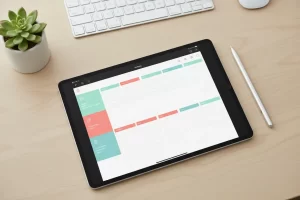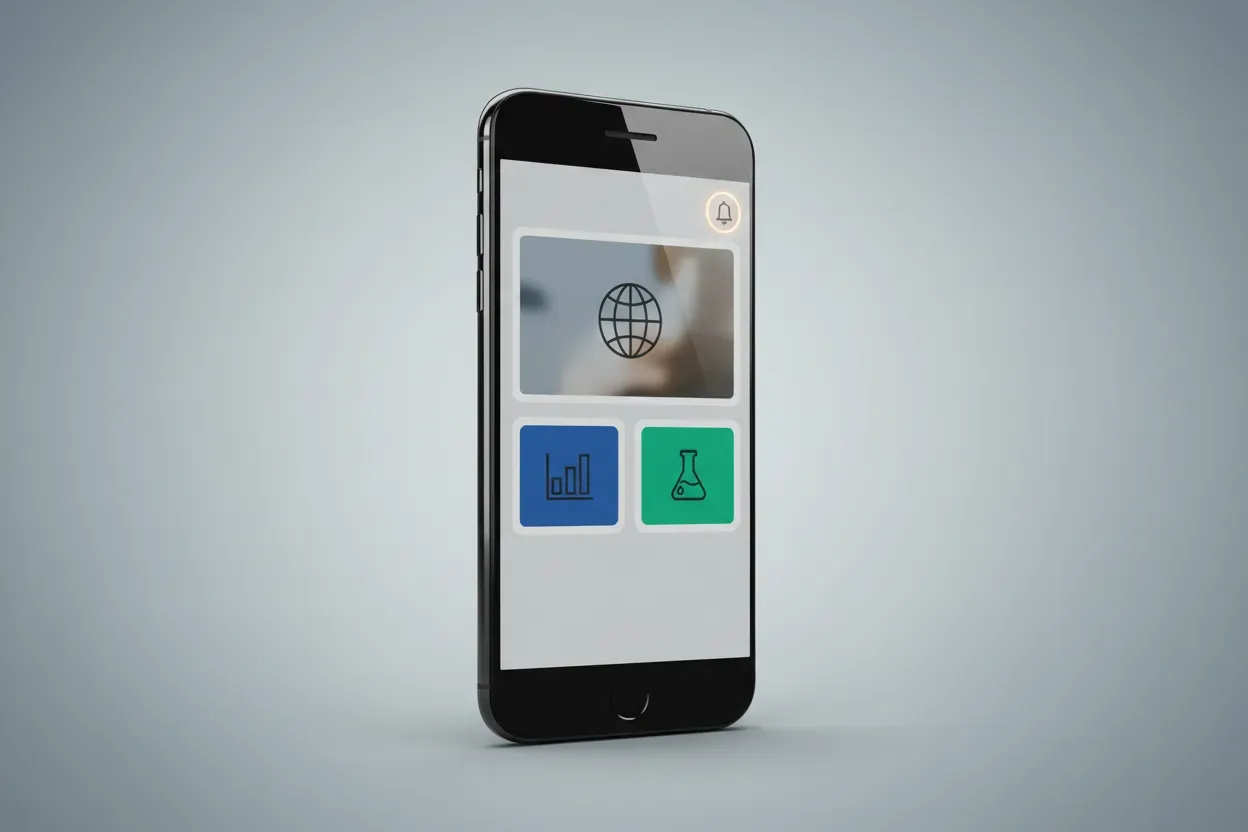20 Must-Have Tools for Improved Business Operations
Gain valuable insights from industry professionals on essential tools to streamline your business operations. This article provides a curated selection of expert-recommended applications designed to enhance efficiency and task management. Discover the transformative impact of these tools on your daily workflows and overall productivity.
- Track Time Precisely with Harvest
- Centralize Project Details Using Asana
- Optimize Site Assessments with Drone Tech
- Automate Workflows with Zapier
- Streamline Projects with Notion and Zapier
- Manage Tasks Efficiently with ClickUp
- Enhance Collaboration with Project Management Tools
- Boost Efficiency with Trello Boards
- Optimize Operations with Facility Management
- Enhance Productivity with ChatGPT
- Streamline Projects Using Trello
- Unify Operations with Orbitype
- Manage Film Budgets with ShowBiz
- Organize Tasks Efficiently with Trello
- Improve Efficiency with Scheduling Software
- Centralize Projects Using Trello
- Organize Projects with Trello
- Optimize Routes with Mileage Mapping
- Enhance Collaboration with Asana
- Automate Tasks with Zapier
Track Time Precisely with Harvest
One piece of technology that has significantly improved our operational processes is Harvest for time tracking. It gives us precise visibility into how time is allocated across projects, which is critical in our business where we often run fixed-price engagements. What sets Harvest apart is how it syncs directly with our invoicing and reporting systems, turning time entries into actionable insights about cost, margin, and team utilization.
A clear example was a fixed-scope SaaS project we delivered over 10 weeks. Since the budget was locked, we had to closely monitor hours to avoid scope creep and protect our margin. With Harvest, we set hourly budgets by task and team member, tracked time daily, and reviewed progress weekly. This allowed us to quickly spot when certain features were absorbing more effort than estimated and reallocate resources to stay on track. At the end of the project, we could clearly see how time mapped to value—and we used those insights to improve future estimates and justify scope changes with the client.
For any business balancing fixed pricing with evolving project demands, Harvest becomes a source of truth that supports better decision-making and financial control without adding administrative overhead.
Centralize Project Details Using Asana
One tool that has significantly improved our business operations is Asana. Before we implemented it, our team struggled with keeping track of tasks and project timelines, often relying on emails and scattered documents. Asana has helped us centralize all project details, assign tasks, and set clear deadlines. For example, on a recent product launch, we used Asana to map out every stage–from product development to marketing and sales–ensuring every team member knew exactly what needed to be done and when. The biggest benefit has been the transparency it provides, allowing us to track progress in real time and address any roadblocks immediately. As a result, our efficiency increased by about 20%, and we’ve been able to meet deadlines with greater consistency, ultimately driving better results for the business.
 Nikita Sherbina
Nikita Sherbina
Co-Founder & CEO, AIScreen
Optimize Site Assessments with Drone Tech
One tool that has significantly improved our business operations at Exactus Energy is drone-based solar site assessment software integrated with GPS mapping and thermal imaging technology. This technology has transformed how we conduct site evaluations, optimize system designs, and streamline project approvals.
How It Has Helped Streamline Processes & Increase Efficiency:
1. Faster and More Accurate Site Assessments
Traditional site assessments often require manual measurements, which can be time-consuming and prone to errors. By leveraging drone technology with GPS mapping, we can quickly capture highly detailed topographical and structural data, ensuring precision in system design. This has cut assessment times by up to 70%, allowing us to handle more projects efficiently.
2. Enhanced Structural and Shading Analysis
Thermal imaging and LiDAR (Light Detection and Ranging) technology allow us to detect roof defects, shading issues, and potential inefficiencies before installation. This ensures that we design solar arrays optimized for maximum energy output and long-term performance, reducing costly adjustments post-installation.
3. Automated Permitting and Compliance
Many jurisdictions have complex solar permitting processes. By integrating drone-generated data with permitting software, we can auto-generate reports that align with local regulations. This minimizes delays, improves submission accuracy, and accelerates project approvals.
4. Scalability for Multi-Regional Expansion
As we expand Exactus Energy’s footprint across North America, standardized digital assessments ensure consistency in project execution, regardless of location. This enables remote collaboration with engineers, technicians, and regulatory authorities without the need for on-site visits.
By implementing these advanced tools, we’ve significantly increased our operational efficiency, reduced project timelines, and improved the overall quality of our solar installations. This technology has been a game-changer in scaling our business while maintaining precision and sustainability.
 Matthew Jaglowitz
Matthew Jaglowitz
CEO, Exactus Energy Inc.
Automate Workflows with Zapier
Zapier has completely transformed how I manage my consulting practice. Before implementing it, I was drowning in manual data entry between my CRM, email marketing platform, and project management tools.
I remember one particularly chaotic week when I missed following up with three potential clients because information wasn’t properly transferred between systems. After setting up automated workflows, client information now seamlessly flows across all platforms. When someone books a consultation, their details automatically populate in my CRM, add them to my email sequence, and create a project folder.
The hours I’ve reclaimed have allowed me to focus on strategy and client relationships rather than administrative tasks. Just last month, I was able to take on two additional clients without feeling overwhelmed – something that would have been impossible with my previous workflow.
The stress reduction alone has been worth every penny, but the increased revenue from better lead management has made it one of the best business decisions I’ve made.
 Volen Vulkov
Volen Vulkov
Co-Founder, Enhancv
Streamline Projects with Notion and Zapier
One tool that has significantly improved business efficiency for me is Notion, integrated with Zapier for automation. It completely changed how I manage projects, collaborate with teams, and streamline daily operations.
I realized the need for a better system after a particularly frustrating week where I spent more time tracking down information than actually working on projects. Notes were scattered across emails, Slack messages, and multiple spreadsheets—it felt like I was piecing together a puzzle every time I needed an update. That’s when I decided to consolidate everything into Notion, turning it into a centralized workspace for project management, documentation, and workflows.
How It Transformed Efficiency:
1. Eliminated Tool Overload – Instead of bouncing between different platforms, Notion became the go-to space for tracking projects, storing important documents, and organizing ideas.
2. Automated Repetitive Tasks – By integrating Notion with Zapier, I set up workflows that automatically logged emails, updated task lists, and even sent reminders, cutting down on manual data entry.
3. Improved Team Collaboration – Everything became transparent—assignments, deadlines, and project statuses were visible in real-time, reducing the need for endless email chains and unnecessary meetings.
One of the biggest wins came when we restructured our content creation workflow. Before Notion, the process involved multiple spreadsheets, email threads, and frequent miscommunications. After setting up a shared content dashboard, everyone could see the pipeline—from brainstorming to final approval—all in one place. The result? A 40% reduction in project turnaround time and smoother collaboration across departments.
Key Takeaway:
If your business is bogged down by scattered information and inefficient workflows, look for a tool that centralizes everything and automates the small tasks. For me, Notion (with automation) became that solution, saving time, reducing friction, and allowing more focus on impactful work rather than administrative busywork.
 Murray Seaton
Murray Seaton
Founder and CEO of Hypervibe / Health & Fitness Entrepreneur, Hypervibe (Vibration Plates)
Manage Tasks Efficiently with ClickUp
One tool that can make a noticeable impact is ClickUp (or something similar like Jira or Asana, depending on the team). It helps when everything—tasks, documents, discussions, and timelines—is managed in one place.
This kind of setup can reduce the chaos of switching between emails, spreadsheets, and chat threads. It helps developers stay focused with clear priorities, while project managers gain better visibility without constantly chasing updates. Automating small tasks—like assigning tasks, setting reminders, or conducting progress check-ins—can save a significant amount of manual effort.
The real benefit is the visibility. When everyone can see what’s going on, where things are stuck, or who’s overloaded, it’s easier to act before problems snowball. That alone can boost team efficiency in a substantial way.
That said, the tool only works if it’s tailored to fit the way the team actually operates. The setup matters just as much as the tool itself.
 Vipul Mehta
Vipul Mehta
Co-Founder & CTO, WeblineGlobal
Enhance Collaboration with Project Management Tools
One piece of technology that has significantly improved our business operations at Software House is project management software. Implementing tools like Trello or Asana has transformed how we collaborate, track progress, and manage tasks. These platforms allow our team to visualize workflows, set deadlines, and assign responsibilities, which has enhanced accountability and streamlined communication.
Additionally, the integration of these tools with other software we use—such as time-tracking and reporting systems—has created a seamless workflow. This technology not only boosts productivity but also enables us to deliver projects on time and within budget. Ultimately, it empowers our team to focus on creativity and innovation rather than getting bogged down in administrative tasks, fostering a more dynamic work environment.
 Shehar Yar
Shehar Yar
CEO, Software House
Boost Efficiency with Trello Boards
One instrumental resource that has considerably enhanced our business operations is Trello, a project management software designed to facilitate the optimization of workflows and maintain organizational structure. Trello’s visual board system enables our team to break down intricate tasks into smaller, manageable components while tracking progress in real-time. Through the use of customizable boards, lists, and cards, we are able to assign responsibilities, establish deadlines, and ensure that all team members remain aligned. This has significantly boosted our efficiency by reducing the need for lengthy email exchanges or meetings to monitor project status. Furthermore, Trello’s integration with other platforms such as Slack and Google Drive enhances collaboration, allowing for seamless access to documents and the communication of updates within the application. The outcome has been a notable decrease in project delays, improved team coordination, and heightened accountability. By consolidating all tasks and updates in a single location, we have streamlined our operations and redirected our focus towards strategic growth rather than becoming mired in logistical challenges.
 Matthew Ramirez
Matthew Ramirez
Founder, Rephrasely
Optimize Operations with Facility Management
Managing office space, assets, and workforce needs efficiently can be challenging, especially as an organization grows. Initially, our approach relied on manual processes and fragmented data, leading to inefficiencies, delayed decisions, and increased operational costs.
Implementing a cloud-based facility management system transformed the way we operate. Real-time space utilization data allowed us to optimize office layouts, ensuring every square foot was used effectively. Automated lease tracking eliminated the risk of missed renewals, while streamlined asset management helped control unnecessary expenditures. Having a centralized dashboard also improved collaboration across teams, enabling quicker, data-driven decision-making.
Beyond automation, the biggest takeaway has been the impact on strategic decision-making. A well-implemented facility management system doesn’t just enhance efficiency – it enables businesses to be more agile, cost-effective, and future-ready.
 Amit Prasad
Amit Prasad
CEO, QuickFMS
Enhance Productivity with ChatGPT
For me, the tool that has significantly improved our business operations is definitely ChatGPT. It hasn’t only simplified specific tasks like refining emails or enhancing marketing content, but it has also streamlined our overall communication and content creation process, making everything more centralized and efficient. Additionally, in sales, it serves as an excellent sparring partner for preparing pitches and discussions, helping me to anticipate questions and formulate clearer, more persuasive responses.
Previously, we implemented various tools like HubSpot, which we still actively use. However, personally, those tools didn’t substantially boost my individual productivity. Having an AI assistant like ChatGPT has been a transformative experience. It has drastically reduced the time spent proofreading and refining content, providing confidence in the quality and professionalism of our communication without the usual stress and redundancy. Overall, this AI assistant has not only streamlined our processes but genuinely enhanced our efficiency and productivity in ways other tools haven’t.
 Niclas M.S.R.H. Brinkmann
Niclas M.S.R.H. Brinkmann
CEO, ForSURE Europe B.V.
Streamline Projects Using Trello
One tool that has significantly improved business operations is Trello. It streamlines project management by providing a visual, intuitive interface that helps teams organize tasks, track progress, and collaborate efficiently. With Trello’s drag-and-drop functionality, teams can manage workflows, assign tasks, and set deadlines, ensuring projects stay on schedule. The integration with other productivity tools like Slack, Google Drive, and automation features through Butler further enhances efficiency by reducing manual work. By centralizing project information in one place, Trello eliminates confusion, improves accountability, and boosts overall productivity, making it an essential tool for businesses looking to optimize their workflow.
 Priyanka Prajapati
Priyanka Prajapati
Digital Marketer, BrainSpate
Unify Operations with Orbitype
Without question: Orbitype.com
Originally built as a low-code content platform, Orbitype has evolved into the core operating layer of our business–combining lead management, internal tooling, data workflows, and even automation into a single, unified system without lock-in.
What makes it so impactful is how it replaces multiple tools we used to duct-tape together. Before Orbitype, we juggled CRMs, internal admin panels, databases, automation tools, and cloud storage and database providers–each with their own workflows and limitations. Now, we’ve consolidated all of that into one modular platform, powered by PostgreSQL and S3, and driven by real-time, SQL-powered APIs.
We use Orbitype to:
• Manage leads with custom data structures tailored to our funnel.
• Track project status across clients and departments using smart views (tables, trees, even meta-mode).
• Send automated emails via webhooks to providers like Sendgrid and Brevo.
• Connect with third-party tools while retaining full ownership of our data.
• Build dashboards and reports directly from live data–no exporting or syncing needed.
The result? Less friction, fewer tools, and faster execution across the board. Developers love the flexibility. Non-technical team members love the intuitive UI. And leadership gets better visibility without extra overhead.
In short, Orbitype has become our business command center–streamlining operations, cutting down on tool fatigue, and giving us the agility to move faster with fewer resources.
If you’re scaling a modern business, having a tool that molds itself to your operations–rather than forcing you into predefined boxes–makes all the difference. Orbitype did that for us.
 Julian Vorraro
Julian Vorraro
CEO, Orbitype.com
Manage Film Budgets with ShowBiz
When coordinating a TV commercial shoot, branded content, or film production on the pristine beaches of Roatan, your budgeting software better not let you down. That’s why at Bronson Film, we’ve made ShowBiz Budgeting the cornerstone of our film budget management system.
I remember the days before we implemented ShowBiz–budget sheets with endless formulas, frantic late-night reconciliations, and the inevitable “where did that money go?” conversations. Those headaches are now behind us.
What makes ShowBiz indispensable for our unique operation is its versatility. The software’s ability to handle multiple currency conversions is crucial when you’re working in production services. The fractionalized account codes let us break down expenses with incredible specificity–essential when tracking everything from local craft services in remote locations to specialized underwater camera equipment for our Bay Islands shoots.
As Honduras’ only full-service production company with a footprint in both the mainland and islands, we juggle diverse production needs daily. ShowBiz’s customizable templates have been game-changers, allowing us to quickly adapt budgets.
The software’s reporting features deserve special mention. We can generate professional, comprehensive reports within minutes. This transparency has been instrumental in building Bronson Film’s reputation for financial accountability.
Our production crew, crisscrossing between the colonial streets of Comayagua, the pristine Caribbean shores of Roatan, and the misty coffee highlands, swears by ShowBiz’s PC Envelope feature. The PC Envelope becomes invaluable for daily expense management. This tool allows our team members to document and categorize expenditures in real-time, even in the most remote locations. The PC Envelope means our line producers maintain budget clarity even when out and about, all without waiting to return to headquarters for proper accounting.
The real magic, though, happens during reconciliation. What used to take weeks now takes days. Every receipt, purchase order, and petty cash transaction finds its proper home in the system, creating a financial story that’s both accurate and accessible.
ShowBiz Budgeting gives Bronson Film the tools to deliver both creative excellence and production accountability–no matter which corner of Honduras we’re showcasing to the world.
 Franco Garuti
Franco Garuti
Managing Partner, Bronson Film
Organize Tasks Efficiently with Trello
One tool that has significantly improved my business operations is Trello, a project management software that helps me stay organized and streamline workflows. Before using Trello, my team and I often struggled with tracking tasks across different departments and maintaining clear communication. With Trello, we created shared boards for each project, and by organizing tasks into columns like ‘To Do,’ ‘In Progress,’ and ‘Completed,’ we gained a clearer view of where each task stood.
What really made a difference was how easily Trello integrates with other tools like Slack and Google Drive, which allowed us to centralize communication and document sharing. This eliminated bottlenecks where information was lost in email threads or missed in meetings.
As a result, we saw a noticeable increase in team collaboration and overall productivity. Tasks are completed faster, and everyone knows what’s expected and when. Trello helped us go from a somewhat chaotic environment to a more efficient, organized workflow, ultimately saving time and reducing mistakes.
 Georgi Petrov
Georgi Petrov
CMO, Entrepreneur, and Content Creator, AIG MARKETER
Improve Efficiency with Scheduling Software
One tool that has significantly improved my business operations is high-quality scheduling and invoicing software. With over 15 years of experience in gardening and landscaping, I’ve seen firsthand how time management can make or break a business. Early on, I was juggling phone calls, paper invoices, and handwritten schedules, which left too much room for errors and miscommunication. Now, with a digital system in place, I can easily manage client bookings, send automated reminders, and generate invoices instantly. This has not only improved efficiency but also enhanced customer satisfaction, as clients appreciate the seamless communication and professionalism.
My qualifications as a certified horticulturist have allowed me to maximize the benefits of this system. By integrating plant care schedules, seasonal maintenance reminders, and custom service recommendations into the software, I can provide tailored solutions for each client’s garden. Instead of spending hours on administrative work, I can focus on what I do best: creating and maintaining beautiful outdoor spaces. The ability to track past services and anticipate future needs has also helped me build long-term relationships with clients, ensuring they receive the best possible care for their gardens.
 Andrew Osborne
Andrew Osborne
Owner, Ozzie Mowing & Gardening
Centralize Projects Using Trello
One tool that has transformed the way I run my business is Trello, a versatile project management software. Before adopting it, I struggled to keep track of tasks, deadlines, and team communication. My desk was cluttered with sticky notes, and important email threads often disappeared in an overwhelming inbox.
Deadlines would occasionally slip through the cracks, and it felt like I was always reacting to problems rather than proactively managing projects. Trello helped centralize everything–tasks, timelines, and team updates–into an intuitive system where I could see the bigger picture while staying on top of the details.
One project vividly stands out. A client requested a fast turnaround on a complex marketing campaign involving design, content creation, and multiple approvals. Using Trello, I broke the project into clear steps, created checklists, assigned tasks to team members, and flagged priorities.
Everyone could see the project flow, deadlines, and progress in real time, which eliminated miscommunication and confusion. We delivered the project ahead of schedule, and the client’s satisfaction was proof of how impactful the tool had been.
The biggest benefit has been efficiency. Tasks that used to take hours to coordinate now take minutes, freeing up time for creative work and relationship building. Trello made teamwork seamless and eliminated the mental clutter of juggling responsibilities.
 Ben H
Ben H
Founder & Owner, Dealmemo
Organize Projects with Trello
One tool that’s been a game-changer is Trello. It’s a simple, visual project management tool that keeps everything organized and on track. We use it to manage client projects, track deadlines, and assign tasks to the team—no more missed steps or getting lost in email threads.
It’s helped us streamline workflows, allowing for clear visibility on what’s done, what’s in progress, and what’s next. The best part? It’s super easy to use, so there’s no learning curve. It’s saved us time, improved communication, and kept things moving smoothly.
 Justin Belmont
Justin Belmont
Founder & CEO, Prose
Optimize Routes with Mileage Mapping
Mileage mapping on a GPS spreadsheet template. Sounds boring, right? But that template single-handedly fixed a problem that cost us over £4,000 in diesel and time last quarter. Before using it, route planning was stuck in the stone age. Dispatchers eyeballed delivery maps, hoping Google Maps would save the day.
Now we track routes by postcode clusters and actual driver history. The system flags any loop longer than five minutes past average. Fuel usage dropped by 18 percent. Complaints about late arrivals? Down to one in a month. Sometimes efficiency looks like an Excel sheet with grit. This one earned its spot.
 James McNally
James McNally
Managing Director, SDVH [Self Drive Vehicle Hire]
Enhance Collaboration with Asana
One tool that significantly improved our business operations is Asana, a project management platform that centralizes task tracking and team collaboration. By organizing workflows, setting deadlines, and assigning responsibilities in one place, we reduced communication gaps and missed tasks. In addition, its visual dashboards and automation features streamlined reporting and project oversight. This approach enhanced accountability and productivity. Ultimately, Asana helped us operate more efficiently, meet deadlines consistently, and scale operations with greater control.
 Brenton Thomas
Brenton Thomas
Founder, Twibi
Automate Tasks with Zapier
One tool that has significantly improved business operations is Zapier. It has helped streamline processes by automating repetitive tasks and integrating various apps without requiring custom coding. For example, at Testlify, we use Zapier to automate candidate assessment workflows, ensuring seamless data transfer between our platform and applicant tracking systems. This has reduced manual work, minimized errors, and saved valuable time. By connecting different tools like Slack, HubSpot, and Google Sheets, Zapier has allowed us to focus more on strategic tasks rather than administrative ones, ultimately increasing overall efficiency.
 Abhishek Shah
Abhishek Shah
Founder, Testlify








































